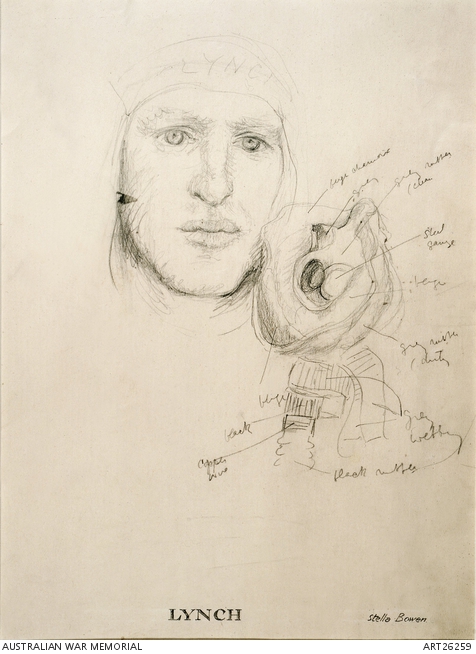Stella Bowen : Art, Love and War
- Periods:
- To England
- An artist's journey
- Inner worlds
- The return to England
- The war years
Period: The war years
Bomber crew
painted in London, 1944
oil on canvas 86.1 x 63.3 cm
signed l.r., oil “STELLA/BOWEN”, not dated
Australian War Memorial
acquired under official war art scheme, 1944
Bomber crew represents the young Australians involved in the air war over Europe. Their bravery and youth captivated Bowen. The work is a group portrait of a Lancaster bomber crew lost on operations on 28 April 1944. She depicted them standing in front of the menacing image of their bomber.
Preoccupied with their flight preparations, the men expressed no particular interest in Bowen’s attempt to draw them. She had only made preliminary sketches when they were reported missing. Bowen returned to her London studio to complete the painting, using her sketches and some photographs of the crew. She wrote, “It was terrible having to finish the picture after the men were lost. Like painting ghosts.”
Bowen’s interest in group portraits stemmed from her discovery of the work of the Italian primitives and from her preference for the decorative portrait over the “tedious realism” of the Royal Academy: “I would much welcome the chance to do group portraits as a formal decorative scheme, with emphasis on linear design. Uniforms and symbols would lend themselves to this treatment.” With Bomber crew, she achieved this long-held aim.
After the crew was lost on operations, Bowen finished the painting using official photographs and the individual sketches she had already made. Indeed, her preferred approach was to draw each figure separately and then arrange them together on the canvas, rather than as if they had all been together in front of her.
One of the men, Pilot Officer Thomas Lynch, who was presumed to have perished with the rest of the crew, was eventually discovered in a German prisoner-of-war camp.
Sketches for Bomber Crew
Flying Officer Francis Jackson, bomb aimer
drawn in London, 1944
pencil on paper 37.8 x 27.6 cm
Australian War Memorial
acquired under official war art scheme, 1944
Flying Officer Marmion Carroll, navigator
drawn in London, 1944
pencil on paper 37.7 x 27.6 cm
Australian War Memorial
acquired under official war art scheme, 1944
Pilot Officer Thomas Lynch, rear gunner
drawn in London, 1944
pencil on paper 37.9 x 27.6 cm
Australian War Memorial
acquired under official war art scheme, 1944
Sergeant D. G. Champkin, flight engineer
drawn in London, 1944
pencil on paper 37.9 x 27.6 cm
Australian War Memorial
acquired under official war art scheme, 1944
Flying Officer Ronald Neal, mid-upper gunner
drawn in London, 1944
pencil on paper 37.9 x 27.6 cm
Australian War Memorial
acquired under official war art scheme, 1944
Squadron Leader Eric Jarman
drawn in London, 1944
pencil on paper 37.9 x 27.6 cm
Australian War Memorial
acquired under official war art scheme, 1944
Flying Officer Hector Harrison, wireless navigator
drawn in London, 1944
pencil on paper 37.9 x 27.6 cm
Australian War Memorial
acquired under official war art scheme, 1944
Paintings
- Julia
- The house opposite
- Flight from reason
- Embankment gardens
- Admiral Sir Ragnar Colvin
- Bomber crew
- Bombing up a Lancaster for Wing Commander Douglas
- Remains of a flying bomb
- Group Captain Hughie Edwards
- D-Day, 0300 hours, interrogation hut
- Flying Officer Frederick Syme, Sunderland captain
- Pilot Officer Ronald Warfield
- A Sunderland crew comes ashore at Pembroke Dock (F. Syme, Ron Warfield, Ron Tyson, Eric Genders, Charlie Martin, Spud Murphy, Bob Meade, Merv Pike, Jock Beattie, Curly Rowland and John Bishop)
- At the Churchill Club, large and small worlds
- RAAF airmen at Mongewell Park Medical Rehabilitation Unit
- Private, Gowrie House
- Repatriated prisoner of war is processed
- Brigadier George Langley
- Reception desk at Gowrie House, Eastbourne
- Theaden in Kensington
- [Flowers in a green Norwegian pot]







